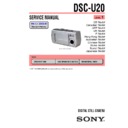Sony DSC-U20 (serv.man3) Service Manual ▷ View online
69
Co
py
ing
py
ing
ima
g
e
s
3
Connecting your camera to your computer
,
Open the jack cover, and connect the
supplied USB cable to your camera.
supplied USB cable to your camera.
• Operations are not guaranteed when using a USB
hub.
,
Connect the other end of the USB cable
to your computer.
to your computer.
The camera is on.
•
The camera can receive power supply from most of the
computers that are recommended for use through the USB
connection (USB Bus Powered), so in this case there is no
need to insert batteries into the camera.
computers that are recommended for use through the USB
connection (USB Bus Powered), so in this case there is no
need to insert batteries into the camera.
•
When using a desktop computer, connect the USB cable to
the USB connector on the rear panel.
the USB connector on the rear panel.
•
When using Windows XP, the copy wizard automatically
appears on the desktop. Proceed to page 74.
appears on the desktop. Proceed to page 74.
1
SONY
2
70
“USB MODE: NORMAL ” appears on the LCD screen.
When a USB connection is established for the first
time, your computer automatically runs the used
program to recognize your camera. Wait for a while.
When a USB connection is established for the first
time, your computer automatically runs the used
program to recognize your camera. Wait for a while.
•
If “USB MODE: NORMAL” is not shown in step 3,
confirm that [USB] is set to [NORMAL] in [
confirm that [USB] is set to [NORMAL] in [
] (page 92).
•
In USB mode, the POWER button, lens cover and other
controls on the camera do not function.
controls on the camera do not function.
Disconnecting the USB cable from your
computer or removing the “Memory
Stick” from your camera during USB
connection
computer or removing the “Memory
Stick” from your camera during USB
connection
For Windows 2000, Me, or XP users
1
Double-click
on the tasktray at the lower right of
the screen.
2
Click
(Sony DSC), then click [Stop].
3
Confirm the device on the confirmation screen, then
click [OK].
click [OK].
4
Click [OK].
This step is unnecessary for Windows XP users.
This step is unnecessary for Windows XP users.
5
Disconnect the USB cable or remove the “Memory
Stick.”
Stick.”
For Windows 98 or 98SE users
Do only step
5
above.
3
USB MODE:NORMAL
When the access lamp is lit up, it means that image
data is being read or written. Never open the
battery/“Memory Stick” cover at this time, as the
data may be damaged.
data is being read or written. Never open the
battery/“Memory Stick” cover at this time, as the
data may be damaged.
71
Co
py
ing
py
ing
ima
g
e
s
4
Copying images
If “Launch Image Transfer automatically” (page 64) is
checked during “Image Transfer” installation, “Image
Transfer” automatically launches during USB
connection and the images are copied.
When copying is complete, “ImageMixer”
automatically launches and a list of images appears.
If “Image Transfer” does not launch automatically,
double-click the “Image Transfer” icon in the tasktray.
checked during “Image Transfer” installation, “Image
Transfer” automatically launches during USB
connection and the images are copied.
When copying is complete, “ImageMixer”
automatically launches and a list of images appears.
If “Image Transfer” does not launch automatically,
double-click the “Image Transfer” icon in the tasktray.
•
Normally “Image Transfer” and “Date” folders are created
inside the “My Documents” folder, and all of the image files
recorded with your camera are copied into these folders.
inside the “My Documents” folder, and all of the image files
recorded with your camera are copied into these folders.
•
You can change the “Image Transfer” settings on the “Image
Transfer Settings” screen (page 76).
Transfer Settings” screen (page 76).
•
When using Windows XP, see page 74.
72
Copying images without using “Image
Transfer”
Transfer”
If you do not set to launch “Image Transfer”
automatically, you can copy images as following
procedure.
automatically, you can copy images as following
procedure.
a
Double-click [My Computer], then
double-click [Removable Disk].
double-click [Removable Disk].
The contents of the “Memory Stick” inserted in
your camera appear.
your camera appear.
• This section describes an example of copying image
files to the “My Documents” folder.
• When the “Removable Disk” icon is not shown, see
page 73.
• When using Windows XP, see page 75.
b
Double-click [DCIM], then double-click
[100MSDCF].
[100MSDCF].
The “100MSDCF” folder opens.
• The folder names vary depending on the type of images
they contain (page 77).
c
Drag and drop the image files into the
“My Documents” folder.
“My Documents” folder.
The image files are copied to the “My
Documents” folder.
Documents” folder.
• When the copy destination already contains an image
with the same file name, the overwrite confirmation
message appears. When you want to overwrite the
existing image with the new one, click [Yes]. In this
time, the original one is deleted. When you do not want
to overwrite it, click [No], then change the file name.
message appears. When you want to overwrite the
existing image with the new one, click [Yes]. In this
time, the original one is deleted. When you do not want
to overwrite it, click [No], then change the file name.
Click on the first or last page to see other DSC-U20 (serv.man3) service manuals if exist.

